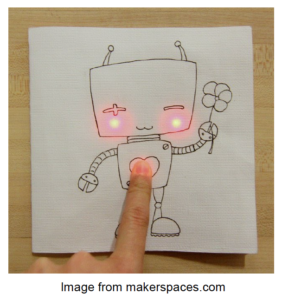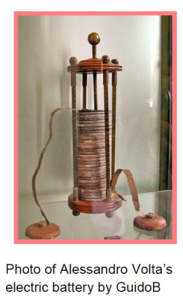INTEGRATING SCIENCE, TECHNOLOGY, ENGINEERING AND MATHEMATICS (STEM) INTO THE HOME ENVIRONMENT
Light It Up
ENGINEERING TASK
After you learn about how to create a simple and parallel circuit, create a paper-based gift that lights up. This could be a greeting card, a bookmark, a name tent, a door sign, an origami figure, etc.
 MATERIALS IN KIT
MATERIALS IN KIT
- 4 Sheets of Scrap Paper
- 3 Sheets of Cardstock
- 5 Sheets of Construction Paper
- 3 Coin Batteries
- 8 LED Lights
- 4 Markers
- 2 Binder Clips
- Pom-poms
- Stickers
- Tape
- Glue Stick
- Scissors
STEP 1—EXPLORE & EXPERIMENT
Watch this video for how to create a simple circuit.
What did you learn? How would you explain this to a friend?
Now it’s your turn!! Use a scrap sheet of paper to create your own simple circuit.
STEP 1—EXPLORE & EXPERIMENT SUPPORT
For additional guidance in how to create a simple circuit using conductive tape, check out the project website from the Exploratium.
STEP 1—EXPLORE & EXPERIMENT
This is a parallel circuit. What do you notice? What is the same and what is different from the simple circuit?

STEP 1—EXPLORE & EXPERIMENT SUPPORT
Optional questions to ask:
- Do you think the positive leg of the three LED lights are on the same side? Why do you think this?
- Why might this be called a parallel circuit?
- LED lights in a parallel circuit share the voltage of the battery. What do you think this means?
- How many LED lights do you think we can light up at one time? Let’s try it out.
STEP 1—EXPLORE & EXPERIMENT
Now it’s your turn again!! Use another scrap sheet of paper to create your own parallel circuit.

STEP 2—PLAN
Now that you are an expert in circuits, what will you create? Design/sketch 2-3 paper-based gifts.
- Who are you designing the gift for?
- What does this individual like/enjoy that you can include in your design?
- How might you make your gift unique?
STEP 2—SUPPORT
Optional questions to ask:
- Will your gift include a simple circuit or a parallel circuit?
- Where will you place your LED light(s)? What about the battery?
- May I suggest you include _____ (e.g., circuit) in your drawing?
- How will ______ (name of individual) know how to light the card up? Should we provide instructions?
STEP 3—CREATE
Pick one of your designs from Step 2 to create.

STEP 3—SUPPORT
Optional questions to ask:
- Describe your approach. What are you thinking?
- Should we create the circuit first or decorate first? Why do you think this?
- I suggest we draw components of the circuit.
- What did we hear in the video that might be useful for us to remember?
DID YOU KNOW…?
 It is often said that Thomas Edison invented the light bulb – failing 10,000 times before he got it to work! What would your life be like without light bulbs? Also, did you know the first battery was invented in 1800 by Alessandro Volta. One problem of the first battery was its short life span – ONE HOUR! About how many batteries would you go through in one day if batteries only lasted one hour?8
It is often said that Thomas Edison invented the light bulb – failing 10,000 times before he got it to work! What would your life be like without light bulbs? Also, did you know the first battery was invented in 1800 by Alessandro Volta. One problem of the first battery was its short life span – ONE HOUR! About how many batteries would you go through in one day if batteries only lasted one hour?8
STEP 4—TEST & IMPROVE
Light it up!
- Would you consider this test a success or failure? Explain.
- What change(s) should we make (i.e., redesign)? What happened in the test that makes you think this?
- What do you know about circuits that might inform your change(s)?
- How many changes did you make before your paper based kit lit up? How does this compare to Thomas Edison failing 10,000 times?
STEP 4—TROUBLESHOOTING TIPS
- Check the battery. Should it be flipped so the positive side of the battery is connected with the positive charge of LED light? When you fold the card, does the conductive tape touch the battery (i.e., closed circuit)?
- Are the LED legs touching the conductive tape?
- Check the tape connections: Use a fingernail or pencil to make sure the tape is firmly adhering to conductive tape and that there is no air bubbles.
- If parallel circuit, are the positive LED lights on the same side?
STEP 5—POSSIBLE EXTENSIONS
- Try an additional design from Step 2. Do each step again— Create, Test, and Improve if needed. Feel free to use or add other creative elements from around your home.
- Create a Commercial. Show how the paper-based gift works. Tell customers where they can buy the gift, and for how much. End with something that will make your gift unforgettable.
- What else might you be able to create using the materials in the kit? Think about a LEGO structure or a shoe box of “secrets.” Develop a plan and develop a prototype.
DID YOU KNOW…?
There are artists, companies, and entrepreneurs that create jewelry, cufflinks, dresses, purses, etc. with circuits and circuit boards.

WHAT TYPE OF ENGINEER ARE YOU?
Add a sticker to your Engineering Passport that identifies the type of engineer you were most like in the design of a paper-based gift. Don’t forget to write why you chose the type of engineer.
